
His UNB education changed his life, so for 50 years Gordon Tracy Alexander (BScE ’48) has shown his gratitude by giving back to UNB.
Gordon came to UNB in 1944, aged 17, from a tiny school in Fredericton Junction. He credits the Lord Beaverbrook Entrance Scholarship with opening the door to a university education, giving him the opportunity to fulfil his dream of becoming a civil engineer.
He loved his time at UNB and immersed himself in the university community, playing intramural hockey and forming lifelong friendships. He graduated with honours in 1948, well prepared for his coming international career.
Upon graduation, Gordon began work as a field construction engineer with the Montreal Engineering Company (later Monenco). His career with Monenco spanned 44 years and saw him move from its construction division to mining, progressing in 1982 to the role of senior vice-president, mining. He was vital to the success of mining developments around the world, for clients that included the United Nations and the World Bank. After his retirement in 1992, he continued to offer his highly sought-after skills as a consultant.
Gordon made his first donation to UNB in 1971, and has given every year since. “The Beaverbrook Scholarship broadened his horizons, and shaped him as a person and as a professional,” said Gordon’s daughter, Jill Alexander. “He was and still is today so grateful, and wants others to benefit from similar opportunities.”
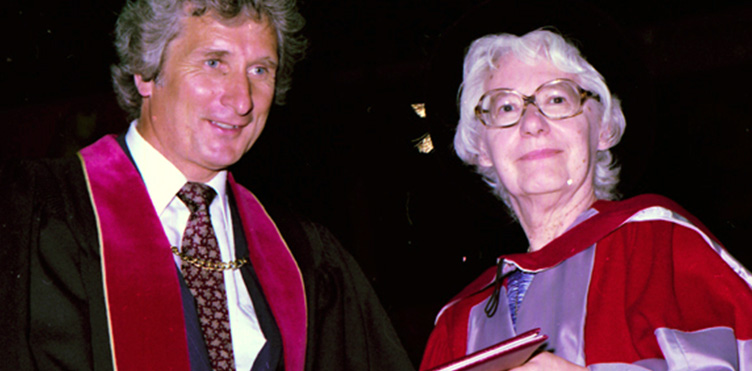
Renowned poet, author, and academic Elizabeth Brewster (1922-2012) had a long, illustrious, and well-travelled career, the roots of which were formed in New Brunswick and at UNB.
Betty Brewster was born in the small logging community of Chipman, N.B., the youngest of five children. She was literary from a young age; her first published poem appeared in the Saint John Telegraph-Journal when she was 12 years old.
Brewster arrived at UNB in 1942 on an entrance scholarship. A shy student, she found a close circle of fellow writers in Fredericton and in 1945 was among the founders of The Fiddlehead, Canada’s longest-running literary magazine. Her one-time professor Desmond Pacey later wrote of her, “there was always behind her timid exterior a character of great strength and toughness, and she was far from defenceless,” adding, “she is a woman of extremely complex sensibility, and of a high degree of self-discipline.”
Self-discipline is certainly evident in Brewster’s academic record. After graduating from UNB with a bachelor of arts, first class honours in 1946, she went on to complete an M.A. at Harvard’s Radcliffe College, a bachelor of library science at the University of Toronto, and a Ph.D. in English at Indiana University.
In 1949, she was awarded a Lord Beaverbrook Postgraduate Overseas Scholarship to study for a year at King’s College London. The Lord Beaverbrook Postgraduate Overseas Scholarship was intended not only for university study, but to allow the recipient to gain life experience through travel, experience Lord Beaverbrook valued highly. Brewster’s year in London went on to inform her poetry throughout her life.
Brewster was one of an elite few women Canadian poets who were published in the 1940s and 1950s, and her accomplishments helped pave the way for generations of poets to come. Her first book of poetry, East Coast, was published in 1951, and over the next six decades she published more than two dozen books of poetry, prose, and memoir. Her final book of poetry, Time and Seasons, was published in 2009 when she was 87 years old.
Early in her career, she worked as a librarian in New Brunswick, Alberta, Indiana and Ontario, and taught English and creative writing at several universities across Canada. In 1972, she joined the faculty of English at the University of Saskatchewan, and there she stayed until 1990.
The impact of Brewster’s work was widely recognized. Along with numerous literary prizes and awards throughout her student years, she received the Saskatchewan Book Award, the Queen’s Diamond Jubilee medal, a Saskatchewan Order of Merit, and, in 1982, an honorary doctorate from UNB. Two of her poetry collections were shortlisted for Governor General’s Awards, and in 2001 she was appointed to the Order of Canada.
Elizabeth Brewster died in 2012 at the age of 90.
The following poem, “Where I Come From,” appeared in Coastlines: The Poetry of Atlantic Canada, published by Goose Lane Editions in 2002.
Where I Come From
Elizabeth Brewster
People are made of places. They carry with them
hints of jungles or mountains, a tropic grace
or the cool eyes of sea gazers. Atmosphere of cities
how different drops from them, like the smell of smog
or the almost-not-smell of tulips in the spring,
nature tidily plotted with a guidebook;
or the smell of work, glue factories maybe,
chromium-plated offices; smell of subways
crowded at rush hours.
Where I come from, people
carry woods in their minds, acres of pine woods;
blueberry patches in the burned-out bush;
wooden farmhouses, old, in need of paint,
with yards where hens and chickens circle about,
clucking aimlessly; battered schoolhouses
behind which violets grow. Spring and winter
are the mind's chief seasons: ice and the breaking of ice.
A door in the mind blows open, and there blows
a frosty wind from fields of snow.
When I was growing up there was no high school in the upper Miramichi Valley. After finishing Grade 8 I told my grandmother, Sarah Ann, that I would sooner go to high school than work in the woods. She went into the bureau drawer in the dining room and lifted the wooden tray that contained knives, forks and spoons. Under the tray was an old envelope. In 1906 when she married Justus Carroll, her aunt Martha Fairley sent her 10 shares of telephone stock as a wedding present. Martha had gone across the New Brunswick-Maine border, enrolled in and graduated from nursing school and then went to Minnesota and found employment with two brothers named Mayo.
Sarah Ann hired Lee Thibadeau who had a car and who would give people a ride for $.10 a mile to take us to Fredericton. We went to the bank to see if the shares were of any value. They were worth enough to pay my room and board in Fredericton for three years. I enrolled in an accelerated program and I was able to finish high school in three years. I had this idea in my head that I wanted to become a surgeon. I wanted to go to UNB to do pre-med but we didn’t have any money. I applied for a Beaverbrook Scholarship.
I finished high school in June 1951. It was haying season but on Friday, July 13, as it was too wet to cut hay so my father, Max (brother) and I went back to the woodlot to cut furnace wood for the next winter. About 3:30 p.m. we were surprised to see George Fairley walking through the woods towards us with a piece of yellow paper in his hand. The only means of communication in those days was to send a telegram. When a telegram arrived in Boiestown it was pinned up on the cork bulletin board at the train station. The idea was that if a neighbour saw a telegram he/she would take it down and deliver it to the named person.
My telegram had arrived on Wednesday, July 11, stating that I had been awarded a Beaverbrook Scholarship (room, board and tuition). I had to reply with my acceptance by 5 p.m. on Friday, July 13.
I dropped my ax and ran home. (Max says I dropped my ax and he hasn’t seen me since.) We didn’t have a car and I needed to travel the seven miles to Boiestown before 5 p.m. We had a saddle horse named Don. His main job was to take us fishing when the water in the Miramichi was too cold to wade. We would fish from Don’s back. Don loved to go salmon fishing. Each time a cast was placed across the water he would watch the fly and if a salmon was hooked he would start backing toward shore so the fish could be landed. I threw the saddle on Don’s back and told him I had to be at the Boiestown Train Station by 4:45. As soon as we cleared the front gate Don broke into a canter and had me at the railway station by 4:43. I asked the stationmaster to telegraph my affirmative reply and he tapped the message out on the telegram key. I told him that my father would pay him the next time he was in town. I then went across the street to McCluskey’s general store and got Don a bucket of oats and an O’Henry chocolate bar for myself. The bucket of oats was 25 cents and the chocolate bar was 5 cents. Again I left the bill for my father.
Don loved his bucket of oats but they gave him terrible gas. On his slow walk back home I was almost asphyxiated in the saddle as the up-river wind was on our backs.
In September I started my bachelor of science courses at UNB.
In October I got to meet the “Beaver!” As was his custom at that time he came across the pond for a six-week stay in Fredericton.
I met him at a dinner he put on for his scholars at, where else, but the Beaverbrook Hotel. When we shook hands I told him that I too had grown up in the Miramichi Valley.
He told me that he had invited Chief Justice Richards who would be sitting on his right side and for me to sit on his left side.
Partway through dinner he said to me “I’m going to tell you the right way to run a meeting. Meetings for the most part are a waste of time. I learned this lesson in Winnie’s War Room (he was referring to the underground bunker or Churchill and his war cabinet met during the war). Churchill’s method of conducting an efficient meeting was to have everyone drink a pint of beer just before the meeting started and to put a lock on the bathroom door. The door wouldn’t be unlocked until the meeting was finished.”
Beaverbrook told me that he couldn’t remember a meeting that lasted more than an hour.
About 10 o’clock he put his arm around the Chief Justice and said “it’s time for old forks like you and me to get home to bed so my scholars can have some fun.” With that he got up and led the Chief Justice away. I assumed they were both gone and helped myself to his recently poured double Chivas. Twenty minutes later the door opened and in walked the Beaver shouting “let’s party!” He immediately headed to the table looking for his scotch; but, alas the glass was empty. He shouted “who the hell drank my scotch?” I raised my hand and told him that my Scottish heritage couldn’t bear the thought of it going to waste. He forgave me!
At that point, accompanied by a pianist, a grand piano was rolled into the room and for the next hour we stood around the piano and sang Miramichi lumberjack songs. The Beaver was in his element!
As an aside my cousin Jim Wilson, with the help of Louise Manning, compiled and published a collection of these lumberjack songs titled Songs of Miramichi.
PS: In August 2019 I got to spend a day in Churchill’s War Rooms and all of the memories of the dinners with the Beaver came flooding back.
Eric Larson’s novel The Splendid and the Vile had a special meaning for me as I knew personally one of the main characters!
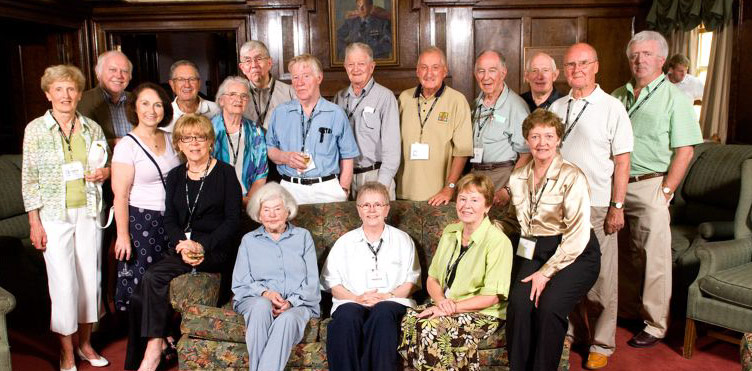
I was a " Double" Beaverbrook Scholar. The first as an undergraduate four-year scholar, in 1945 graduating with a bachelor of science (honours biology).
You may look me up in the 1949 yearbook - science section. Then I became an Overseas Beaverbrook Scholar at University College, London, doing genetics research and studies.
It was in London, England, that we met at the "Beaver's" London residence and also at his country home in Leatherhead, Surrey.
We were invited to his granddaughter's coming out party at Claridge's, and introduced us to various British cabinet ministers. I remember him teasing me about studying with a communist professor J.B.S. Haldane (an editor of the Daily Worker). He himself was of course, a press lord, the publisher of the Daily Express. Although very polite to "his" scholars, we witnessed his temper with his newspaper editors!
Attached is a write up about my career after "My Beaverbrooks."
Sincerely,
Benjamin Goldberg, BSc, MD, CM, FRCPC, OOnt

I graduated from UNB in 1957 with a bachelor of science (honours) with a major in geology and was awarded a Lord Beaverbrook Overseas Scholarship.
In 2013, Bob Skillen sent me a copy of Bob McLaughlin's book on the history of the scholarships. Arnie McAllister was also involved in having Beaverbrook alumni support entrance scholarships. I have ties to Bob, Arnie and Lord Beaverbrook. In 1957, I was rooming with the McLaughlin family when I was awarded the scholarship. I studied geology under Arnie and in the summer of 1957 before leaving for England, I was employed by Arnie who was consulting in northern New Brunswick.
In September 1957, I enrolled in geology at University College London. Thus began one of the most memorable, enriching, wonderful years of my life. In November 1957, I was invited to the conferring of honorary degrees by the Queen Mother Elizabeth. I had the opportunity to speak to Her Majesty at a reception following the ceremony.
In March 1958, I was invited to a tea party hosted by Lord Beaverbrook for all Beaverbrook scholars. I regretfully sent my apologies as I had to go on a University geological field trip in Cornwall. Upon my return, I received a note March 24 that Lord Beaverbrook was anxious to meet with me before he left London. I scheduled an appointment and had an unforgettable one-on-one meeting with him. (See accompanying copies of notes).
Sadly, some time after our meeting, my father died suddenly and I returned to Canada. On May 16, 1958, I received a condolence letter from His Lordship, and also regretting that I had to leave and he wished me well with my studies at Queen's. Salutation and typing suggests Lord Beaverbrook typed it himself? "What a great man." (See copy of note).

When geneticist and senior scientist emeritus Dr. Johanna Rommens (BSc'80, PhD'86) was first featured in Alumni News magazine in 1996, she was riding the high of accomplishing breakthrough research that would change the fate of those diagnosed with cystic fibrosis (CF). It was a few years earlier, in 1989, that Dr. Rommens, as part of a small team at SickKids in Toronto, identified and cloned the CFTR gene, which when mutated, is responsible for causing CF.
The lead author of the gene-cloning paper, Dr. Rommens remembers her excitement that day. “It was a Friday in June 1989 and I was reasonably certain we had the right gene. I couldn’t sleep a wink that night. It was terribly exciting to think about how much of a difference this could make for patients and their families. It was a huge stride for patient survival and preventing serious outcomes.”
She would continue with ground-breaking research in her career, also discovering the gene responsible for Shwachman-Diamond syndrome, a rare genetic disorder that causes pancreatic and hematologic problems. “It’s a rare disease and I observed that clusters of genetic diseases have commonalities, and we can learn so much from one to the other. These related pathways allow us to think about therapeutics we can use in common.”
Before she became a global superstar in molecular genetics, Dr. Rommens studied at UNB to earn an undergraduate degree in biology and organic chemistry. She’d moved to Fredericton from her home in Melrose, New Brunswick, where her parents – immigrants from Holland – ran a dairy farm. “I always wanted to be a scientist, and my father encouraged it. I received a Beaverbrook Scholarship and that had a big influence on me, because a kid from rural New Brunswick doesn’t usually believe they can be a professor. It gave me the confidence that I could do it.”
During her graduate studies she focused on synthetic chemistry as well as molecular biology and received her PhD from UNB in 1986. “It was at this moment in time when DNA sequencing and new technology were becoming available, and I started dreaming of working at SickKids. I thought it was a pipedream.”
It wasn’t.
She was hired at the Hospital for Sick Kids that very year as a post-doc in the lab of Lap-Chee Tsui, a highly respected geneticist. Dr. Rommens was also made a professor at the University of Toronto.
“The past 30 years have really been the golden era of human genetics and I’ve been lucky enough to be a part of it. Families spend amongst the happiest or saddest days of their lives at SickKids, and this translates to us that have opportunity to work there. But to be in both the practical world of a hospital and the theoretical world of the university is wonderful. I explore abstract thinking but dwell in practical limitations.”
Dr. Rommens says she fell in love with human genetics because it’s about people. “It’s a special kind of science – a human science about families and inheriting genes. I love being able to be in the hospital working on the people side of things.”
Over the years, Dr. Rommens says that ambitions got higher and the expectations to do more, quickly, grew. “It’s slow work and I hope we can keep moving faster, because we need to keep making big steps. The contributions of genetics have been enormous for aging and health, and we’ve seen lately how fast we sometimes need to move to respond to needs. There’s a lot of pressure, and public distrust in science is worrying. The expectations are that everything is either yes or no, but in reality, it’s a lot of gray.”
As she looks back over the decades, she’s as passionate as ever. “When I was young and ambitious, I didn’t dwell on grayness. As you get older, you realize it’s more complicated. But the advances made are amazing. We now study huge groups of people and are getting a good handle on health and wellness and preventing disease.”
Dr. Rommens is still at SickKids and although semi-retired, still involved in a couple of CF projects. “What else would I do? It’s hard to imagine not doing this work if I’m healthy and able.”
With the discoveries that she and colleagues around the world are making, she may very well be able for quite some time.
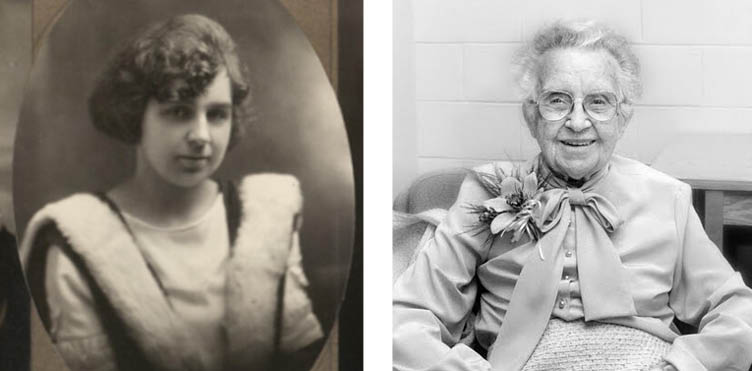
The first female Beaverbrook Scholar and one of Canada’s first female psychologists, Florence Thompson Snodgrass had a remarkable academic career that spanned more than five decades, beginning and ending at the University of New Brunswick.
Born in Young’s Cove, NB, in 1902, Florence arrived at UNB in 1920 as one of the first cohort of four Beaverbrook Scholarship recipients. Without the scholarship, which she considered to be a “fluke” in a time when women were not encouraged to attend university, she later said that she would not have considered pursuing a degree.
Florence excelled as a UNB student, winning the Governor General’s Gold medal and graduating with a Bachelor of Arts in 1924. While her intention was to teach school after graduation – which she did for several years – it was a course taught by Dr. Wilfred Keirstead that inspired in her a lifelong passion for the study of psychology.
After teaching high school mathematics in Michigan and New York, Florence earned a Master’s in Education from Harvard University in 1927, having filled her course roster with as much psychology as the education curriculum would allow. She soon accepted a position in the department of psychology and education at Washington College in Maryland. Unwilling to give up a paid career during the Depression in order to further her studies in psychology, she stayed at Washington College for twelve years, pursuing graduate studies on weekends at nearby Johns Hopkins University. In the early 1940s, she enrolled in a doctoral program in psychology at Yale University. Although her studies were interrupted by five years spent in New Brunswick caring for ailing parents, she earned a PhD in psychology from Yale in 1949.

In 1950, Dr. Snodgrass returned to UNB as Head of the Department of Psychology. Under her leadership, the department saw tremendous growth – introductory psychology enrolment, for instance, grew from fewer than 20 people to more than 450. During her 17-year tenure, she faced significant resistance from a university administration reluctant to provide funding and research space to the emerging field of psychology. Despite many obstacles and great difficulty in attracting high-quality scholars, she persevered – and succeeded in establishing a modern department with an excellent reputation. With her direction, the psychology department gained a new, state-of-the-art home in Keirstead Hall in 1968.
Florence Snodgrass was named UNB’s first female Professor Emerita in 1974. UNB is home to several bursaries and awards established by and in honour of Dr. Snodgrass; among these is a fund established by Dr. Snodgrass in support of New Brunswick students in need, to which she left what was, at that point, the University’s largest-ever bequest by a faculty member. In 1991, a newly renovated lounge in Keirstead Hall was dedicated to her.
Florence Snodgrass died in 1997 at the age of 94, having set a high bar for generations of Beaverbrook Scholars to follow.
Bill was born on the Ides of March, on March 15, 1932, in Napan Bay. He attended a one room school until Grade 7, when he began studies at the school in Chatham. Bill was a top student throughout his school years. In 1949 he received a Beaverbrook Scholarship and began university at UNB, where he graduated with first class honors.
He excelled in teaching at NSER and Chatham High School, where he served as principal. In 1967 he was selected as the District 10 Superintendent, where he remained for 21 years until his retirement in 1988.
Bill was a Charter member of the Chatham Rotary Club and served as its first secretary and also its second president.
He was an advisory member of the Hotel Dieu Hospital, and served as chair of the Miramichi Hospital Board and a trustee for fourteen years.
Bill served on the UNB Alumni at Miramichi and was president of the Miramichi Curling Club.
He played an active role in St. Andrews United Church, serving as a Sunday School teacher, on the Board of Stewarts, with Presbytery, and as Church organist and choir.
Bill was proud to be named as a Paul Harris Fellow and Honorary Life Member of the Chatham Rotary Club in 2022.
He was honored to receive the Queen's Silver Jubilee Medal in 1977.
In September of 1989, at Toronto, Ontario, the Canadian Association of School Administration presented Life Membership to William Sweezey in recognition of his outstanding service to Education in Canada. What an achievement!
Bill is a fine example of an outstanding individual and citizen of Miramichi.
Bill's wife, Donna, passed away in 2019, however, his four devoted children keep a close eye on their beloved father.
As early as 1958, Dr. Uffe Blok-Andersen set a goal to establish a scholarship, administered by those who had "benefitted by Lord Beaverbrook’s generosity.” More than 20 years later, a group of his fellow Beaverbrook Scholars joined him in establishing the Beaverbrook Scholars Award.
The driving force behind the Beaverbrook Scholars Award was Dr. Uffe Blok-Andersen (BSc 1945, LLD 1990). Born in Denmark, Uffe’s family immigrated to rural New Brunswick when he was four years old, and like many, they struggled to make ends meet throughout the 1930s. Uffe came to UNB in 1941 as a Beaverbrook Entrance Scholar. The student body was small during the war years, but Uffe was an active part of campus life – he worked on the Brunswickan, played interclass hockey and varsity football, served as president of the chemical society, and edited the yearbook.
After graduation, Uffe’s degree in chemistry served him well as he worked first for Dow Chemical and later established his own successful business, UBA Chemical Limited, based in Toronto. Ever grateful to UNB and to Lord Beaverbrook for the opportunities he received early on, Uffe set about trying to establish a scholarship – the goal being, in his words, “to provide unto others a scholarship by those who earlier had benefited by Lord Beaverbrook’s generosity.” That award ultimately became the Beaverbrook Scholars Award.
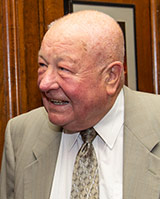 John Bliss, 1950 Beaverbrook Entrance Scholar, graduated with a Bachelor of Science in Civil Engineering in 1955. John had a long and successful engineering career until his retirement in 1998 as City Engineer for Fredericton. In 2008, the E. John Bliss Water Treatment Plant was named in his honour.
John Bliss, 1950 Beaverbrook Entrance Scholar, graduated with a Bachelor of Science in Civil Engineering in 1955. John had a long and successful engineering career until his retirement in 1998 as City Engineer for Fredericton. In 2008, the E. John Bliss Water Treatment Plant was named in his honour.
John was a well-known philanthropist beyond his efforts co-founding the Beaverbrook Scholars Award. Along with funding scholarships at UNB, he gave generously of both time and money to such organizations as Theatre New Brunswick, the Beaverbrook Art Gallery, Fredericton YMCA and the Fredericton Community Foundation. In 2008, he was recognized by his alma mater with the Alumni Award of Honour.
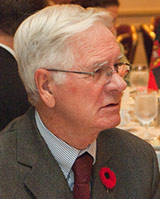 Ray W. Dixon, Q.C. was a 1955 Beaverbrook Entrance Scholar who went on to complete three degrees at UNB: a BA in 1960, BEd in 1961, and a Bachelor of Common Law in 1965.
Ray W. Dixon, Q.C. was a 1955 Beaverbrook Entrance Scholar who went on to complete three degrees at UNB: a BA in 1960, BEd in 1961, and a Bachelor of Common Law in 1965.
Like many other recipients, Ray has credited Lord Beaverbrook and the Beaverbrook Scholarship with allowing him to attend university. Ray was 16 when his father died, leaving his mother to raise five children on a potato farm in Victoria County, New Brunswick. At UNB, he made lifelong friendships within the Lady Beaverbrook Residence – in fact, his first date with Dorothy, his wife of sixty years, was at the residence’s Fall Prom. He went on to a successful career in the law, practicing for a remarkable 46 years until his retirement in 2011. Today, he and Dorothy live in Fredericton, N.B.
Harold Gunter came to UNB from Saint John as a Beaverbrook Entrance Scholar in 1949. He was active in many campus activities during his time at UNB, including the motorcycle club, engineering society, and the radio club.
After graduating in 1954 with a Bachelor of Science in Engineering (Electrical Engineering), Harold went on to a long and distinguished engineering career. Today, Harold Gunter is retired and lives in Bath, Maine.
UNB Professor Emeritus Dr. Arnold (Arnie) L. McAllister (BSc 1943) was born in Petitcodiac, NB, in 1921. He came to UNB as a Beaverbrook Entrance Scholar in 1939 and graduated as valedictorian and gold medallist for varsity sports.
After serving overseas until the end of the war, Arnie went on to McGill University as a Sir James Dunn Scholar, graduating with a PhD in Geology in 1950. After two years working as a research scientist for International Nickel in Sudbury, Arnie and his growing family returned to UNB, and there he stayed until his retirement in 1984. Arnie is remembered as an international leader in geological research, a beloved professor, and a loyal fan of the UNB Red Devils hockey team.
Dr. Barb Pepperdene came to UNB in 1955 as a Beaverbrook Entrance Scholar and graduated in 1959 with a Bachelor of Arts. She is believed to have been the first UNB student to pursue Honours in Sociology, which shared a department with Anthropology at that time. After receiving her PhD in Occupational Sociology, Barb returned to UNB, and here she spent the majority of her teaching career.
Along with her generosity in helping to establish the Beaverbrook Scholars Award, Barb established two prizes at UNB. She is remembered as an insightful and engaging teacher who cared deeply about her students.
Dr. Harold W. Touchie was born in Renous, N.B. and grew up in Moncton. Like many of his fellow Scholars, he was able to attend university thanks to the funding he received from the Beaverbrook Entrance Scholarship. After he attained a Bachelor of Science in 1962, he went on to graduate from Dalhousie Medical School in 1967.
After practicing in Saint John and moving to Vancouver to complete a specialization in orthopaedic surgery, Harold returned to New Brunswick, settling in Fredericton with his wife and five children. A prominent and active community member, he supplemented his clinical practice with research and teaching, and took pride in being a life-long learner. In 2012, he was awarded Life Membership in the New Brunswick Medical Society. Dr. Harold Touchie lives in Fredericton.
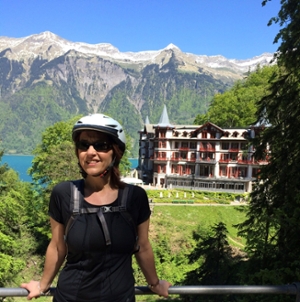
When Lianne Smith-Stow arrived at UNB in 1981 as the first Beaverbrook Scholars Award recipient, she was also the first in her family to attend university.
Receiving the BSA allowed Lianne to focus fully on her studies and ultimately graduate debt-free with a Bachelor of Business Administration.
While at UNB, Lianne had the opportunity to meet the founders and benefactors of the BSA. She enjoyed learning about Lord Beaverbrook through their stories and felt honoured to have been chosen by them for the inaugural award. “I remember looking forward to the annual dinner for Beaverbrook Scholars, which made me feel special and encouraged me to keep striving for academic excellence,” she said.
Lianne has fond memories of her time at UNB. “Attending UNB broadened my horizons and allowed me to interact with people from other cultures and other parts of Canada I previously had no exposure to,” she said, adding that she credits her UNB experience with instilling a lifelong passion for travel and experiencing new cultures.
A campus job fair led to a job with NBTel in Saint John for two years after graduation. She then attended Queen’s University, graduating with an MBA specializing in Corporate Finance and attaining her professional accounting designation.
Early in her career, Lianne married an air force pilot and spent several years moving around Canada and the US, followed by a six-year stint travelling the world working in corporate finance for McCain Foods. In 1998, Lianne and her husband settled in Barrie, Ontario. There, she changed careers yet again and became a professor, teaching accounting, finance and taxation courses, most recently at Georgian College.
Lianne shared a “full circle” experience connecting her teaching career to her time at UNB: “It was a unique moment for me when I shared with my first-year university Accounting students that the book they were learning from was written by my first Accounting Prof from UNB – Barbara Trenholm!”
Lianne and her husband are recently retired and have three grown sons. That love of travel ignited as a UNB student continues today, with cycling holidays being the couple’s favourite way to travel. To date, they have had cycling adventures in Switzerland, the Greek Islands, Italy, Croatia, Holland and Belgium, with more adventures to come as travel restrictions ease in the coming months. And when they are not travelling, they look forward to spending their summers at their Miramichi cottage, back home in New Brunswick.
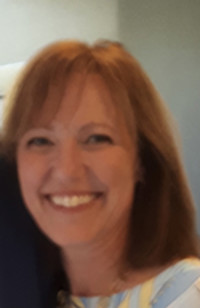 Pauline Lordon (BSA 1985) grew up, like Lord Beaverbrook, in Miramichi. She came to UNB Fredericton not only as a Beaverbrook scholar but as a highly sought-after basketball player, and to say she thrived is an understatement. During her time playing for UNB she earned accolades such as UNB Female Athlete of the Year, Eric Garland Award for All Round Athlete of the Year, and CIS All Canadian. She was team captain and MVP for four years running, honing leadership skills she has continued to apply throughout her life both on and off the court.
Pauline Lordon (BSA 1985) grew up, like Lord Beaverbrook, in Miramichi. She came to UNB Fredericton not only as a Beaverbrook scholar but as a highly sought-after basketball player, and to say she thrived is an understatement. During her time playing for UNB she earned accolades such as UNB Female Athlete of the Year, Eric Garland Award for All Round Athlete of the Year, and CIS All Canadian. She was team captain and MVP for four years running, honing leadership skills she has continued to apply throughout her life both on and off the court.
After graduation, Pauline moved to coaching, leading the UNB women’s basketball team to the Atlantic University Sport championship in 1993-94 and earning herself the title of AUS Coach of the Year in the process. Her coaching career took her with Team Canada to the FIBA Americas Tournament and to the 1996 Olympics in Atlanta. She has been named the 3M Sport Canada Coach of the Year and inducted into both the Miramichi and the New Brunswick Sports Halls of Fame. This list only scratches the surface of her accomplishments and contributions to women’s basketball — at UNB and across the country.
Beyond basketball, Pauline has led in her community and career, with more than 30 years of experience as a coach and manager. She has received the NBCC-CCNB Provincial Leadership Excellence Award for her work as Department Head and the annual Volunteer Recognition Award from the Town of Rothesay. Pauline continues to be a leader at UNB, too, having served as chair of the Beaverbrook Scholars Award Committee and as a member of the university’s Board of Governors for nine years.
“I am deeply grateful to have received the Beaverbrook Scholars Award during my time at UNB,” Pauline said. “My experience as both a student and a varsity athlete was truly transformative. The award gave me the freedom to fully focus on my studies without the burden of financial stress, offering me an incredible opportunity. Moreover, the founders and members of the Beaverbrook Scholars Award have had a lasting impact on me through their remarkable generosity and commitment to serving others — values I hope to embody in my own life.”